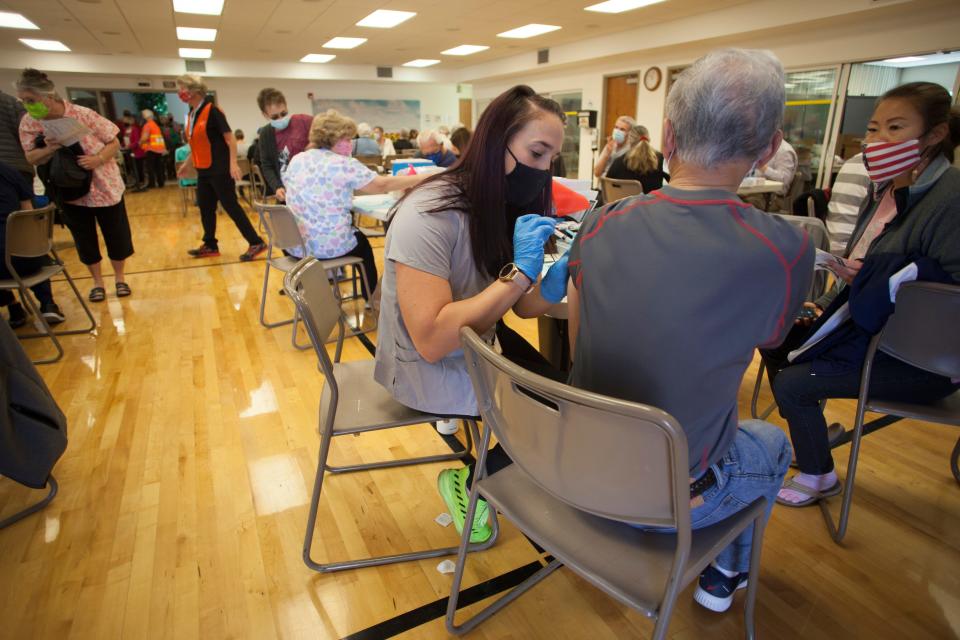Utah health officials urge vaccination as flu, COVID-19 rates rise
Amid rising rates of hospitalizations from respiratory illnesses, Utah health officials are again urging residents to get vaccinated for the flu and COVID-19.
Prevention methods practiced at the beginning of the COVID-19 pandemic helped limit seasonal respiratory illnesses, but with safety measures more relaxed, experts predict a busy season this winter for respiratory illnesses.
Hospitals statewide reported an increase in the number of children who required hospitalization for RSV, and flu numbers were expected to increase in the coming weeks as winterlike temperatures moved into Utah, according to officials with the Utah Department of Health and Human Services.

Combined with what health officials expected to be a busier winter surge of COVID-19, a "tripledemic" of RSV, flu, and COVID-19 could present major problems for state hospitals.
“The real concern in this term ‘tripledemic’ comes from the idea that they all may hit about the same time,” says Andrew Pavia, MD, chief of the Division of Pediatric Infectious Diseases at University of Utah Health. “This could overwhelm many of our health systems.” These systems are already struggling with staff shortages and exhaustion after almost three years of COVID-19.
While people who get COVID-19 can still get sick even after they've had a vaccine, they should have less severe symptoms and have a far lower chance of requiring a hospital stay or dying. The new bivalent COVID-19 vaccine contains two components to provide better protection against the omicron variant.
"Being up-to-date on your immunizations not only protects you but may also help protect those around you who are at higher risk for becoming seriously ill with respiratory illness such as babies, young children, older adults, people who are pregnant, and those who have chronic health conditions," according to an advisory published by the DHHS office.
Flu vaccines this year have been updated to combat four separate flu viruses that are expected to circulate around the state and the rest of the U.S. Flu vaccines are typically readily available and free for those interested. Vaccine locations can be found easily at vaccines.gov/find-vaccines.

"Flu severity in Utah is low right now, but we have seen a growing trend in residents who seek treatment for flu and flu-like illness," said Janelle Delgadillo, an epidemiologist with the DHHS. "There is not a vaccine for RSV, but there are vaccines for flu and COVID-19. Getting a flu vaccine and being up-to-date with your COVID-19 vaccines are the best way to reduce your risk of illness."
Without a vaccine available for RSV, parents and those who care for young children can take some precautions. Healthcare officials recommend avoiding close contact with sick people and taking typical steps to prevent illness, such as regularly washing hands and covering up when coughing or sneezing.
RSV (respiratory syncytial virus)
RSV is a common infection that causes cold-like symptoms in most people. Cases of RSV typically increase from late fall to early spring. Both adults and children can get infected with RSV, but the virus can be more serious for young children and older adults. RSV can cause bronchiolitis and pneumonia in children younger than one. About 50,000 kids are hospitalized for RSV each year.
Flu
Flu or Influenza is an infection of the nose, throat, and lungs. It causes 20,000 to 50,000 deaths each year in the U.S., with the exception of the last two years due to the COVID-19 pandemic. Flu was largely absent in the winter of 2020-21 and relatively mild last winter.
The flu can cause severe illness, hospitalization, and death in people of all ages — but children under age two, adults older than 65, pregnant women, people with conditions such as heart disease, lung disease and diabetes, and people with weakened immune systems are more vulnerable and more likely to get severely ill.
COVID-19
COVID-19 is a respiratory illness that causes a wide range of symptoms ranging from mild to severe and often deadly infection. Cases of COVID-19 have typically increased in the fall and peak in the winter, although this can depend on new emerging variants of the COVID-19 virus. Infectious disease experts expect an upcoming surge due to the emergence of several subvariants of Omicron.
This article originally appeared on St. George Spectrum & Daily News: 'Tripledemic' of flu, RSV, COVID-19 has health experts worried

